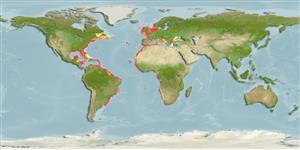>
Tetraodontiformes (Puffers and filefishes) >
Balistidae (Triggerfishes)
Etymology: Balistes: Latin, balista, -ae = crossbowman. In Greek, ballo = to throw (Ref. 45335); capriscus: Specific name 'capriscus' meaning a small goat; probably referring to its 'face' which looks like a small goat (to be confirmed)...
More on author: Gmelin.
Environment: milieu / climate zone / depth range / distribution range
Ecologia
marino associati a barriera corallina; distribuzione batimetrica 0 - 100 m (Ref. 7348), usually 0 - 55 m (Ref. 55172). Tropical; 58°N - 37°S, 98°W - 36°E
Western and Eastern Atlantic:
Length at first maturity / Size / Peso / Age
Maturity: Lm 17.0, range 13 - 29.7 cm
Max length : 66.0 cm TL maschio/sesso non determinato; (Ref. 127374); common length : 44.0 cm TL maschio/sesso non determinato; (Ref. 47377); peso massimo pubblicato: 6.2 kg (Ref. 40637); Età massima riportata: 15 anni (Ref. 107826)
Spine dorsali (totale): 3; Raggi dorsali molli (totale): 26-29; Spine anali 0; Raggi anali molli: 23 - 26. Tall, with a small mouth and plate like scales (Ref. 35388). Three faint irregular broad dark bars on body; a narrow pale transverse band on chin; small light blue spots on upper half of body and median fins, and irregular short lines ventrally (Ref. 13442).
Inhabits bays, harbors, lagoons, and seaward reefs (Ref. 9710). May drift with young at surface among Sargassum (Ref. 9710). Usually solitary or in small groups (Ref. 9710). Feeds on benthic invertebrates like mollusks and crustaceans (Ref. 4727). Oviparous (Ref. 205). Consumed mostly fresh, smoked, and dried salted. The flesh is of excellent quality. Because it is resistant to capture, it proliferates and competes for food with other species (Ref. 5377).
Adults guard the embryos nested in sand which hatched in about two days (Ref. 9778).
Smith-Vaniz, W.F., B.B. Collette and B.E. Luckhurst, 1999. Fishes of Bermuda: history, zoogeography, annotated checklist, and identification keys. American Society of Ichthyologists and Herpetologists Special Publication No. 4. 424 p. (Ref. 35505)
IUCN Red List Status (Ref. 130435)
Threat to humans
Reports of ciguatera poisoning (Ref. 30911)
Human uses
Warning: mysqli::__construct(): (HY000/1040): Too many connections in /var/www/html/includes/func_getlabel.php on line 46
Can't connect to MySQL database (fbapp). Errorcode: Too many connections
